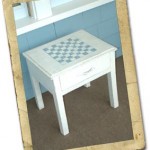 Yesterday, I was sitting in my little cubicle at work, happily typing away on the computer, when I suddenly realized that the other people in the office were talking about me with a salesperson from Wyrick’s Office Supplies. Talking and laughing. Mostly laughing.
Yesterday, I was sitting in my little cubicle at work, happily typing away on the computer, when I suddenly realized that the other people in the office were talking about me with a salesperson from Wyrick’s Office Supplies. Talking and laughing. Mostly laughing.
See, let me backpeddle for a second and explain: our Office Manager decided last week that it was time to buy a new chair for me. Mine is old, uncomfortable and miserable to sit in for any length of time. (In fact, I’m pretty sure it was used in England in the middle ages as a device of torture.) And so, it was decreed that I could have a new chair–hence the visit from the Wyrick’s salesperson and the conversation that occurred yesterday.
Now, that’s fine and I have no problem at all with people talking about me when they’re buying me a new chair. Or when they’re buying me anything, really. Especially electronics. Buy me electronics and you have license to talk about me all you want. It’s one of my bylaws. But in this instance, as I mentioned, along with the conversation, there was a lot of stifled laughter. And also a lot of laughter that wasn’t so stifled. In fact, if I had to classify it, I’d rank the bulk of the laughter between a “guffaw” and a “belly-laugh”.
And so, after a few minutes of this, I tried to poke my head over my cubicle so I could see what was going on. But, of course, I couldn’t see over the cubicle because I’m . . . well . . . short. And so I dragged a paint can over so I could climb on that and peak over and see what was going on. As I did so, I heard the other people say, “Oh, he’s dragging his paint can over now so he can peak over the cubicle and see what’s going on.”
And when I finally did manage to peak over the edge of the cubicle, everybody–salesman included–erupted in laughter that was definitely bordering on “belly-laugh”.
Well, trying to maintain my dignity, I said, “What’re you talking about?”
And the Office Manager simply said: “We’re picking out a chair for you.”
Now, I may be short, but I’m not dumb. I knew what was going on. And so I said “Oh, you’re trying to find a chair little enough for the short guy?”
And without missing a beat, the Office Manager explained that they were asking if Wyrick’s could get a chair that had a little fold-out ladder thing “so you can clamber up into your chair.”
So I can “clamber” up into my chair? Rats and mice and other rodents clamber. I’m more of a “jumper” or a “leaper”.
At any rate, the minute she said that, everybody started laughing again and then the sales guy, in all seriousness, started flipping pages and said, “Well, I don’t think I’ve got anything with a ladder . . . but here’s a chair that automatically lowers itself to about 1 1/2 foot off the ground.” He then looked at me and I thought–for a horrible second–that he was going to whip out a measuring tape and try to see if I could manage to get into a chair that was 1 1/2 foot off the ground. He was still undecided when someone else shouted: “We could always just lift him up and put him in it every morning.”
That seemed to satisfy the salesman and he went back to his catalog, flipping pages and pointing out different chairs that were apparently designed for the severely height-disabled. Before he’d gone too far, my Office Manager chimed up again–sounding very serious when she did so: “Can we have him try some of these out–you know, to make sure his legs don’t swing back and forth all day long? Because I bet that can get uncomfortable.”
“Yeah,” someone else shouted (it was amazing how many people wanted to take part in the “Buy Dan a Chair” discussion), “when my 8 year old nephews go for a ride in the car, their legs go to sleep when they have to have them dangling over their car seats….”
8 year old nephews? Car seats? Little dangling legs? I cleared my throat–to let them all know I was still standing right there–but they didn’t seem to care. They were laughing, having a great time, looking at all the features that chairs come with and seeing which features might work for “the little guy.”
Finally, I decided that nothing was to be gained by standing there listening to it all, so I threw in my two cents. I said that since we were looking for features in a chair for me, I’d like most of all to have a chair that I could drive around the office–like one of those Little Rascals or those “Hoveround” chairs or whatever they’re called. You know, the ones that the old people drive to the Grand Canyon and then sit on the edge cheering? Yeah, I’d like one of those.
Think how awesome that would be: Walking to the bathroom wouldn’t be work anymore. It’d be like being at Craig’s Cruisers on the Go-Cart track all day long. I could zip and weave around the paint cans and the shelves and the boxes. I could drive out to the back of the plant to throw my coffee cups away in the dumpster and then I could drive back. I could drive over to the fax machine to send a fax. Drive to the copy machine to make copies or scan stuff. Drive to the printers, drive to the coffee pot, drive to my car at the end of the day and then hire somebody to drive my chair back to the office. After they lifted me and put me in my car. Because really, we must be honest here: all that driving around instead of walking is likely going to take a toll on my leg muscles.
Yeah, I was just getting into the idea of having a Little Rascal chair of my own when the Office Manager killed my dream. “You’re not getting a Little Rascal. The only bells and whistles you’re getting on your new chair is a step-stool. So you can get in and out without having to be helped.”
And of course, that started the laughing up all over again. I backed away and went back to my desk, dragged my paint can over to my old chair and clambered back onto the seat. With my legs swinging happily over the edge, a good 4 inches from the ground, I fired up my computer and went back to work…. But really, I spent the rest of the day thinking about all the things I’d do with a Little Rascal.



 Well, I’ve got a flat tire. Right now. In fact, I’m writing this from the lobby of the tire repair shop. And of course, to be perfectly honest, I’m kind of half-expecting someone to walk over to tell me, “Sir, the tire’s all fixed and ready to go, but we decided to take a look around and noticed that that motor’s leaking all kinds of Chromascopic oils and your Magnesium Regulator is completely empty. On top of all that, your Obstingent Flux Nexometer is completely shot.” (I’m not a car person, so as intelligent as I sound, I just want you to know that I’m making up names…)
Well, I’ve got a flat tire. Right now. In fact, I’m writing this from the lobby of the tire repair shop. And of course, to be perfectly honest, I’m kind of half-expecting someone to walk over to tell me, “Sir, the tire’s all fixed and ready to go, but we decided to take a look around and noticed that that motor’s leaking all kinds of Chromascopic oils and your Magnesium Regulator is completely empty. On top of all that, your Obstingent Flux Nexometer is completely shot.” (I’m not a car person, so as intelligent as I sound, I just want you to know that I’m making up names…) no-brainer, but believe me, people forget this all the time. Repainting and sealing your water stains on the ceiling will be an exercise in futility if you don’t first find the source of the problem and repair it. Get a roofer out to your home if necessary. Tighten your plumbing connections. Install some heat tapes on your roof if the leaks are from ice backup. Whatever you need to do, find the source of the leak and fix it.
no-brainer, but believe me, people forget this all the time. Repainting and sealing your water stains on the ceiling will be an exercise in futility if you don’t first find the source of the problem and repair it. Get a roofer out to your home if necessary. Tighten your plumbing connections. Install some heat tapes on your roof if the leaks are from ice backup. Whatever you need to do, find the source of the leak and fix it.
 It’s been a while since we tossed up a “quick hitter” project–a project that should take you less than a couple hours and cost you less than $40–so I thought I’d pitch this one to you: painting an accent wall.
It’s been a while since we tossed up a “quick hitter” project–a project that should take you less than a couple hours and cost you less than $40–so I thought I’d pitch this one to you: painting an accent wall.

 Painting a checkerboard design on a table is a great project that will infuse your front porch (or wherever) with that old-fashioned, laid- back feeling we all associate with a game of checkers. It’s simple, quick and best of all, will probably cost you less than $20 (including the table).
Painting a checkerboard design on a table is a great project that will infuse your front porch (or wherever) with that old-fashioned, laid- back feeling we all associate with a game of checkers. It’s simple, quick and best of all, will probably cost you less than $20 (including the table). 2. Paint the Table (if necessary)
2. Paint the Table (if necessary) roll of safe-release masking tape available at your local home center or hardware store. Purchase the roll in the width that you drew your squares. (If you drew 2″ squares, go with the 2″ tape, etc.) Tape around the edges of the entire board and then tape off alternating lines and alternating squares (see inset).
roll of safe-release masking tape available at your local home center or hardware store. Purchase the roll in the width that you drew your squares. (If you drew 2″ squares, go with the 2″ tape, etc.) Tape around the edges of the entire board and then tape off alternating lines and alternating squares (see inset). 3e touch, or you can leave this part of the project for another day. Just use light pressure with some 150 grit sandpaper and dust over the entire surface of the table. Continue this until the checker board pattern is sufficiently distressed. Wipe the table clean with a slightly damp rag and, when it’s dry, either leave it as is or apply a single coat of a flat polyurethane varnish or a spray lacquer. (Be advised, unless you use a water-based polyurethane or a non-yellowing lacquer, this protective coat will yellow slightly over time.)
3e touch, or you can leave this part of the project for another day. Just use light pressure with some 150 grit sandpaper and dust over the entire surface of the table. Continue this until the checker board pattern is sufficiently distressed. Wipe the table clean with a slightly damp rag and, when it’s dry, either leave it as is or apply a single coat of a flat polyurethane varnish or a spray lacquer. (Be advised, unless you use a water-based polyurethane or a non-yellowing lacquer, this protective coat will yellow slightly over time.)
 Just before Christmas, my wife and I decided to go through the kids’ toys and get rid of the stuff we didn’t need. With Christmas coming and the inevitable influx of new toys, we figured we’d need to make space. And so we decided to do some heavy-duty toy cleaning. (Which is just another way of saying “we used garbage bags.”)
Just before Christmas, my wife and I decided to go through the kids’ toys and get rid of the stuff we didn’t need. With Christmas coming and the inevitable influx of new toys, we figured we’d need to make space. And so we decided to do some heavy-duty toy cleaning. (Which is just another way of saying “we used garbage bags.”)
 For the last few posts, I’ve been writing about removing clutter from our homes. And some of you might be wondering why. I mean, really, why would RepcoLite Paints–a company who sells paint–be spending time on a topic like this?
For the last few posts, I’ve been writing about removing clutter from our homes. And some of you might be wondering why. I mean, really, why would RepcoLite Paints–a company who sells paint–be spending time on a topic like this?